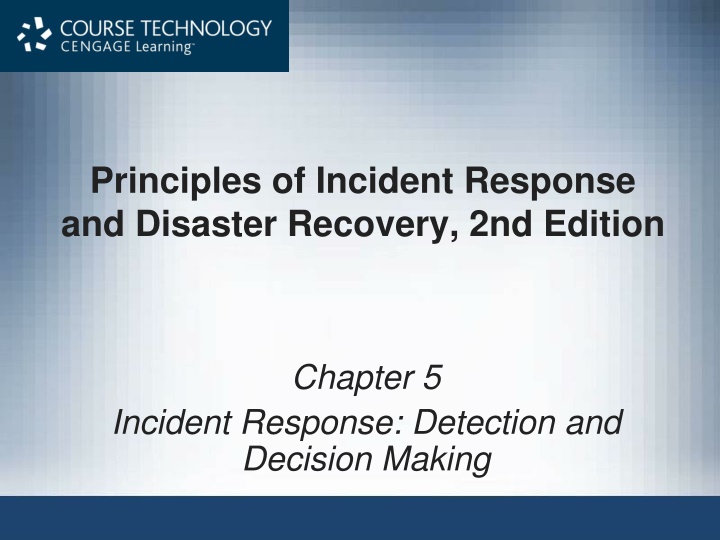
Incident Response and Detection: Key Principles and Processes
Explore the essential elements of incident detection, classification, and response in the realm of cybersecurity. Learn about identifying incidents, designing incident response processes, and classifying network-based incidents according to the NIST scheme.
Download Presentation

Please find below an Image/Link to download the presentation.
The content on the website is provided AS IS for your information and personal use only. It may not be sold, licensed, or shared on other websites without obtaining consent from the author. If you encounter any issues during the download, it is possible that the publisher has removed the file from their server.
You are allowed to download the files provided on this website for personal or commercial use, subject to the condition that they are used lawfully. All files are the property of their respective owners.
The content on the website is provided AS IS for your information and personal use only. It may not be sold, licensed, or shared on other websites without obtaining consent from the author.
E N D
Presentation Transcript
Principles of Incident Response and Disaster Recovery, 2nd Edition Chapter 5 Incident Response: Detection and Decision Making
Objectives Define incidents that pose a risk to the organization Discuss the elements necessary to detect incidents Explain the components of an intrusion detection and prevention system Describe the processes used in making decisions about incident detection and escalation Principles of Incident Response and Disaster Recovery, 2nd Edition 2
Introduction Organizations challenge Classifying events as they occur Event Any observable system or network occurrence Adverse event Event with negative consequences Systems: computer, personnel, organization based Not all events computer or network oriented Event sources Product of routine system activities, critical situations Principles of Incident Response and Disaster Recovery, 2nd Edition 3
Introduction (contd.) Incident Occurs when an adverse event becomes a genuine threat to ongoing operations Incident classification process Evaluating circumstances around events Determining possible incidents (incident candidates) Determining if adverse event constitutes an actual incident Incident response (IR) design team role Designing the process used to make a judgment Principles of Incident Response and Disaster Recovery, 2nd Edition 4
Introduction (contd.) IR team responsibility Classifying an incident Sources for tracking and detecting incident candidates End user reports and other documents Intrusion detection and prevention systems (IDPSs) Virus management software Systems administrators Careful incident candidate reporting training Allows vital information to be relayed to the IR team Principles of Incident Response and Disaster Recovery, 2nd Edition 5
Introduction (contd.) NIST incident classification scheme for network- based incident Denial of service Malicious code Unauthorized access Inappropriate usage Multiple component Principles of Incident Response and Disaster Recovery, 2nd Edition 6
Detecting Incidents Events occurring in and around an organization May indicate presence of an incident candidate May be normal operation mimicking incident candidate Indication: adverse event underway Has probability of becoming an incident Precursor: activity now occurring Incident could occur in the future D. L. Pipkin incident indicator categories Possible, probable, and definite Principles of Incident Response and Disaster Recovery, 2nd Edition 7
Possible Indicators of an Incident Presence of unfamiliar files Unfamiliar or unexplained files in illogical locations Presence or execution of unknown programs or processes Unfamiliar programs running, or processes executing Unusual consumption of computing resources Memory or hard disk consumption spikes and falls Unusual system crashes System crashing, hanging, rebooting, or freezing more frequently than usual Principles of Incident Response and Disaster Recovery, 2nd Edition 8
Principles of Incident Response and Disaster Recovery, 2nd Edition 9
Probable Indicators of an Incident Activities at unexpected times Network traffic levels exceed baseline levels Presence of unexpected new accounts Periodic review indicates unfamiliar accounts Unlogged new account with root or special privileges Reported attacks Verify user technical sophistication Notification from IDPS Must determine if notification real or a false positive Principles of Incident Response and Disaster Recovery, 2nd Edition 10
Definite Indicators Definite indicators requiring IR plan activation Use of dormant accounts Changes to logs Presence of hacker tools Notifications by partner or peer Notification by hacker Confirmed events indicating attack underway Loss of availability or integrity or confidentiality Violation of policy or violation of law Principles of Incident Response and Disaster Recovery, 2nd Edition 11
Identifying Real Incidents Actual incidents versus nonevents Vast majority of incidents: false positives Ways to process incidents Incident center; geographically separate review locations; isolated incident candidate evaluations Noise: legitimate activities wrongly reported Activate feedback process to prevent flagging Inherent in the nature of best-tuned systems Causes of noise or false positives Sensor placement; policy; lack of awareness Principles of Incident Response and Disaster Recovery, 2nd Edition 12
Identifying Real Incidents (contd.) Data collection tuning process Provides careful change analysis to data collection rules False negative Incident deserving attention that is not reported New or modified systems placed in service May need additional data collection process tuning Tuning process objective Allow valid incidents while controlling false positives Principles of Incident Response and Disaster Recovery, 2nd Edition 13
Intrusion Detection and Prevention Systems Intrusion detection and prevention system (IDPS) Network burglar alarm Determines if network used in compliance with policy Intrusion Instigator attempting to gain unauthorized entry or disrupt normal operations Access outside intended system or network use Attack types: automated or self-propagating Purpose of intrusion: harm an organization Principles of Incident Response and Disaster Recovery, 2nd Edition 14
Intrusion Detection and Prevention Systems (cont d.) Intrusion detection systems (IDSs) Detects a violation and activates an alarm Alarm types: audible, visual, silent Custom configuration levels available Intrusion prevention system (IPS) Detects intrusion and prevents successful attack using an active response IDPS source http://csrc.nist.gov/publications/nistpubs/800- 94/SP800-94.pdf Principles of Incident Response and Disaster Recovery, 2nd Edition 15
IDPS Terminology Alarm or alert Indication system just attacked or under attack Alarm clustering Consolidation of almost identical alarms into a single higher-level alarm Alarm compaction Form of alarm clustering based on similarities Alarm filtering Process of classifying attack alerts to distinguish or sort false positives from actual attacks more efficiently Principles of Incident Response and Disaster Recovery, 2nd Edition 16
IDPS Terminology (contd.) Confidence value Value associated with an IDPS s ability to detect and identify an attack correctly Evasion Process by which attacker changes network packets format and/or timing to avoid being detected False attack stimulus Event triggering alarms causing false positive when no actual attack in progress False negative IDPS s failure to react to an actual attack event Principles of Incident Response and Disaster Recovery, 2nd Edition 17
IDPS Terminology (contd.) False positive Alarm or alert indicating attack in progress or attack successful when there is no attack Filtering Process of reducing IDPS events in order to receive a better confidence in the alerts received Noise Ongoing activity from alarm events Site policy Rules and configuration guidelines governing IDPSs implementation and operation Principles of Incident Response and Disaster Recovery, 2nd Edition 18
IDPS Terminology (contd.) Site policy awareness IDPS s ability to dynamically modify its site policies in reaction or response to environmental activity True attack stimulus Event triggering an alarm causing IDPS to react as if a real attack were in progress Tuning Process of adjusting an IDPS Maximize true positive detection efficiency Minimize both false positives and false negatives Principles of Incident Response and Disaster Recovery, 2nd Edition 19
Why Use an IDPS? Prevent problem behaviors Increase perceived risk of discovery and punishment Detect attacks and security violations Not prevented by other security measures Detect and deal with preambles to attacks Document existing threat to an organization Act as quality control for security design and administration Especially of large and complex enterprises Provide useful information about intrusions Principles of Incident Response and Disaster Recovery, 2nd Edition 20
Why Use an IDPS? (contd.) Straightforward deterrent measure Increases fear of detection and discovery among would-be attackers or internal system abusers NIST defined uses Identifying security policy problems Documenting the existing threat to an organization Deterring individuals from violating security policies Provides cover if network: Fails to protect itself from known vulnerabilities Unable to respond to rapidly changing threat environment Principles of Incident Response and Disaster Recovery, 2nd Edition 21
Forces Working against an IDPS Tools fail to detect or correct a known deficiency Vulnerability-detection performed too infrequently Patch and upgrade installation delayed Inability to disable or protect essential services Use an IDPS for a Defense in Depth strategy Doorknob rattling conducted by footprinting Fingerprinting Early warning allows time to prepare for attack Automated responses lead to unintended consequence Principles of Incident Response and Disaster Recovery, 2nd Edition 22
Justifying the Cost Prepare and defend business case using IDPS data NIST IDPS key items Total cost of ownership well exceeds acquisition costs Designed with personnel availability around the clock Justify IDPS using Defense in Depth concept IDPS can provide information in post-attack review Remedy deficiency and trigger improvement process Forensic data IDPS systems: Network-based, host-based, and application-based systems Principles of Incident Response and Disaster Recovery, 2nd Edition 23
IDPS Network Placement Placement of sensor and detection devices or software programs Has significant effect on IDPS operation Three widely used IDPS placement options Network-based Host-based Application-based Principles of Incident Response and Disaster Recovery, 2nd Edition 24
Network-Based IDPS Network-based IDPS (NIDPS) Monitors segment traffic Looks for ongoing or successful attack indications Resides on a computer or appliance connected to that network segment Programmed to recognize attacks and respond Examines packets Looks for patterns indicating intrusion event under way or about to begin Detects more attack types than host-based IDPS More complex configuration, maintenance program Principles of Incident Response and Disaster Recovery, 2nd Edition 25
Network-Based IDPS (contd.) Inline sensor Deployment on firewall interior of a firewall All traffic must pass through sensor, then report back to the NIDPS NIDPS deployment Watch specific host computer grouping on specific network segment Installed to monitor all traffic between systems making up an entire network Principles of Incident Response and Disaster Recovery, 2nd Edition 26
Principles of Incident Response and Disaster Recovery, 2nd Edition 27
Network-Based IDPS (contd.) Passive sensor Sits off to the side of a network segment Monitors traffic without mandating traffic physically pass through the sensor Switched port analysis (SPAN) port or mirror port Switch or key networking device placed next to a hub NIDPS uses that device s monitoring port Snort open source software (http://www.snort.org) For complex IDPS sensors and analysis systems Manage and query system from a desktop computer Principles of Incident Response and Disaster Recovery, 2nd Edition 28
Principles of Incident Response and Disaster Recovery, 2nd Edition 29
Network-Based IDPS (contd.) Signature matching NIDPSs look for attack patterns Compares measured activity to known signatures in their knowledge base Determines if attack occurred or may be under way Uses special TCP/IP stack implementation NIDPS looks for invalid data packets Application protocol verification Higher-order protocols examined for unexpected packet behavior or improper use May have valid packets excessive quantities Principles of Incident Response and Disaster Recovery, 2nd Edition 30
Network-Based IDPS (contd.) Signature matching (cont d.) DNS cache poisoning Valid packets exploit poorly configured DNS servers Inject false information Corrupt servers answer to routine DNS queries from other systems on the network Wireless NIDPS Monitors and analyzes wireless network traffic Looks for potential problems with wireless protocols Sensor deployment: at the access points, on specialized components, or in mobile stations Principles of Incident Response and Disaster Recovery, 2nd Edition 31
Network-Based IDPS (contd.) Wireless NIDPS (cont d.) Centralized management stations collect information Detection Unauthorized wireless LANs (WLANs) and WLAN devices; poorly secured WLAN devices; unusual usage patterns; use of wireless network scanners; DoS attacks and conditions; impersonation and man- in-the-middle attacks Issues Higher protocol monitoring; physical security; sensor range; access point and wireless switch locations; wired network connections; cost Principles of Incident Response and Disaster Recovery, 2nd Edition 32
Network-Based IDPS (contd.) Advantages and disadvantages of NIDPSs Principles of Incident Response and Disaster Recovery, 2nd Edition 33
Host-Based IDPSs Host-based IDPS (HIDPS) Resides on a particular computer or server (host) Monitors activity on that system Known as system integrity verifiers Benchmarks and monitors key system files status Detects when intruder creates, modifies, or deletes monitored files Can monitor system configuration databases and stored configuration files Uses principle of configuration or change management Principles of Incident Response and Disaster Recovery, 2nd Edition 34
Host-Based IDPSs (contd.) Host-based IDPS (cont d.) Alert or alarm triggers File attributes change, new files created, existing files deleted Can monitor systems logs for predefined events HIDPS log file provides an independent audit trail Very reliable False positive alert produced only when authorized monitored file changed Can access encrypted information Information to determine legitimate traffic present Principles of Incident Response and Disaster Recovery, 2nd Edition 35
Host-Based IDPSs (contd.) HIDPS configuration Simple change-based system Relies on file classification into various categories Triggers alert on changes within a critical data folder Can log all activity and instantly page or e-mail any administrator Can generate large volume of false alarms Can monitor multiple computers simultaneously Must identify and categorize folders and files Common method: red, yellow, and green Some systems use an alternative scale of 0 100 Principles of Incident Response and Disaster Recovery, 2nd Edition 36
Principles of Incident Response and Disaster Recovery, 2nd Edition 37
Host-Based IDPSs (contd.) Advantages and Disadvantages of HIDPS Principles of Incident Response and Disaster Recovery, 2nd Edition 38
Application-Based IDPS Application-based IDPS (AppIDPS) Examines an application for abnormal events Looks for anomalous occurrences Tracks interaction between users and applications Allows tracing of specific activity back to individual users Can view encrypted data Types of requests examined File systems, network, configuration, execution space The need for intrusion detection is organization dependent Principles of Incident Response and Disaster Recovery, 2nd Edition 39
Application-Based IDPS (contd.) Advantages and disadvantages of AppIDPS Principles of Incident Response and Disaster Recovery, 2nd Edition 40
Principles of Incident Response and Disaster Recovery, 2nd Edition 41
IDPS Detection Approaches Signature-based IDPS (knowledge-based) Examines data traffic in search of patterns matching known signatures Weaknesses Signatures must be continually updated Time frame over which attacks occur Anomaly-based IDPS (behavior-based IDPS) Samples network activity and applies statistical analysis against a baseline Clipping level Measured activity outside baseline parameters Principles of Incident Response and Disaster Recovery, 2nd Edition 42
IDPS Detection Approaches (contd.) Anomaly-based IDPS (cont d.) Advantage Can detect new attack types Disadvantages Requires overhead and processing capacity May not detect minor changes to system variables generating false positives Principles of Incident Response and Disaster Recovery, 2nd Edition 43
IDPS Detection Approaches (contd.) Log file monitor (LFM) Type of IDPS similar to the NIDPS Reviews servers, network devices, other IDPSs log files Can look at multiple log files from a number of different systems Uses a holistic approach Requires considerable resource allocation Principles of Incident Response and Disaster Recovery, 2nd Edition 44
Automated Response New systems can respond incident threats autonomously Based on preconfigured options Goes beyond usual IDPS and IPS defensive actions Trap and trace Uses a combination of resources to: Detect an intrusion Trace the intrusion back to its source Allows security administrators to take the offense Legal issue: temptation to back hack Principles of Incident Response and Disaster Recovery, 2nd Edition 45
Automated Response (contd.) Honeypots and honeynets Honeypots Servers configured to resemble production systems Closely monitored network decoys Advantages Distracts adversaries from more valuable machines Provides early warning about new attack trends Allows in-depth examination of adversaries Two general types Production and research Principles of Incident Response and Disaster Recovery, 2nd Edition 46
Automated Response (contd.) Honeytoken System resource placed onto a functional system No normal use for that system Unauthorized access triggers notification or response Honeynet (honeypot farm) High-interaction honeypot Designed to capture extensive information on threats Network of systems designed for attackers interaction Inbound connections: indicates probe, scan, attack Outbound connections: indicates system compromise Principles of Incident Response and Disaster Recovery, 2nd Edition 47
Automated Response (contd.) Legal issues with honeypots and honeynets Line between enticement and entrapment Fourth amendment to the U.S. Constitution Electronic Communications Protection Act Pen Register, Trap and Trace Devices law (Pen/Trap statute) Wasp trap syndrome Downside of current enhanced automated response systems may outweigh the upside Principles of Incident Response and Disaster Recovery, 2nd Edition 48
Incident Decision Making Incident known to be underway Must determine actual incidents and false positives US-CERT steps to detect incidents Collect incident candidates using well-documented procedures Investigate candidates using systems and methods at your disposal If candidate not authorized activity Immediately initiate intrusion response procedures NIST recommendations Profile networks and systems Principles of Incident Response and Disaster Recovery, 2nd Edition 49
Incident Decision Making (contd.) NIST recommendations (cont d.) Understand normal behaviors Use centralized logging; create a log retention policy Perform event correlation Keep all hosts clocks synchronized Maintain and use a knowledge base of information Use Internet search engines for research Run packet sniffers to collect data and filter data Consider experience as being irreplaceable Create diagnosis matrix for less-experienced staff Seek assistance from others, when needed Principles of Incident Response and Disaster Recovery, 2nd Edition 50






















